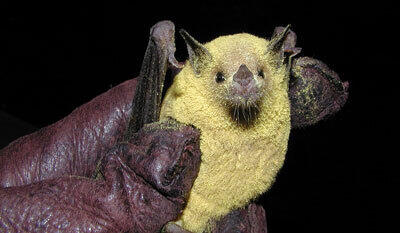Throughout this past month, bats may have been on your mind as they flit across movie screens and adorn homes as adorably creepy seasonal decorations. While these creatures have a reputation as spooky icons, inspiring folktales and popular pop culture characters like Count Dracula, their real-life roles in ecosystems across the world are both fascinating and essential. From pest control to pollination to seed dispersal, bats offer numerous ecosystem services that we benefit from (Kunz et al., 2011). It is no coincidence that Halloween coincides with Bat Week (October 24th-31st), an annual celebration to dispel myths and misinformation about bats and raise awareness about the urgent need for their conservation. In the spirit of the season, I implore you to look beyond their eerie image and explore the vital contributions these charismatic mammals make to our lives.
Worldwide, there are more than 1,400 species of bats, accounting for roughly 20% of all mammals (Simmons et al., 2007). Bats can be found almost everywhere on Earth excluding the most extreme desert and polar regions– no matter where you live, you’re pretty much guaranteed to be sharing space with these winged creatures. Bats are the only mammals that can fly, and they come in a diverse array of shapes and sizes; the Kitti’s Hog-nosed Bat (Craseonycteris thonglongyai) is the world’s smallest mammal, weighing less than a penny, while the Giant Golden-crowned Flying Fox (Acerodon jubatus) has wingspans up to 6 feet wide (Fenton & Simmons, 2015). Though even the largest bats are still on the smaller side relative to other mammals, they break the rule of longevity that says that the smaller the animal, the shorter the lifespan. In fact, bats are the longest-lived mammals relative to their body size (Jones et al., 2005). On average, bats live to be 20 years in the wild, but the oldest recorded species lived to be an astounding 41 years (Hutson et al., 2001).
Bats emerged in the fossil record during the Eocene Epoch 50 million years ago and have since diversified into many ecological roles, or niches, that are often driven by dietary specialization (Teeling et al., 2005). While the Common Vampire Bat (Desmodus rotundus), the White-winged Vampire Bat (Diaemus youngi), and the Hairy-legged Vampire Bat (Diphylla ecaudata), are famously known for feeding on the blood of birds, cows, goats, and pigs, the majority of bats in North America are insect specialists, using echolocation to track their prey (Simmons et al., 2007). Each night, a bat can eat up to its body weight in insects (Kunz et al., 2011). In doing so, bats keep ecosystems in check, as these nightly insect feasts prevent crops from devastation caused by insect larvae. Some studies estimate that across all agricultural production, consumption of insects by bats results in at least $3.7 billion in savings each year– we have bats to thank for doing a lot of natural pest control (Boyles et al., 2011).
Though many people associate pollination with butterflies, bees, and hummingbirds, bats are also important pollinators, especially in tropical and desert ecosystems. Species like the Lesser Long-nosed Bat (Leptonycteris yerbabuenae) feed on nectar and pollen of agave and cacti (Vogel, 2006). Bats and agave have a mutualistic relationship; pregnant bats drink the sweet nectar of agave flowers to fuel up for their annual migration between Mexico and the U.S. Southwest, after which they give birth to a single pup. Agave and other plants like guavas, bananas, and durian rely on bats for reproduction, making bats essential for the growth of species that contribute to regional biodiversity, and in some cases, human economies. For instance, a study of pitaya (dragon fruit) pollination by bats in the genus Leptonycteris found that when bats were excluded from flowers, ensuring they were only pollinated by diurnal birds and insects, pitaya yields and fruit quality decreased substantially, thereby reducing their economic value (Tremlett et al., 2019).

Like birds, some bats are also seed dispersers, aiding in reforestation efforts. Some tropical fruit bats carry seeds inside them as they digest fruit, then excrete the seeds away from the tree they originated from. The seeds drop to the forest floor encased in bat fertilizer, helping them germinate and grow (Altringham, 2011). As research on neotropical bats in cleared and fragmented Central and South American forests suggests, even small species like Tent-making Bats (Uroderma bilobatum) play an important role as agents of the dispersal of up to 44-65 large seeded plants (Murray et al., 1994).
Not only do bats service the environment in myriad ways, their presence or absence help us determine how other species in their ecosystem are doing. In many places, bats are seen as “indicator species,” meaning that the stability of their populations signal an ecosystem’s overall health (Murray et al., 1994). Unfortunately, experts estimate that 52% of North American bat species are at risk of severe population declines over the next 15 years, indicating a need for intervention for the sake of bats and other species in their communities (US Fish and Wildlife Service, 2015). At large, bats today are facing numerous threats that require our direct action, including habitat loss and degradation, climate change, and disease. As forests are cleared for agriculture, urban development, and resource extraction, bats lose essential foraging and roosting sites. This loss is especially detrimental to species that rely on large, undisturbed forest areas to seek out food resources and successfully rear their young. Habitat fragmentation also isolates bat populations, reducing genetic diversity and making it difficult for bats to migrate or find new roosts. Climate change is also hindering bats’ access to food resources and suitable roosting sites. Changes in temperature and precipitation patterns can disrupt insect populations, which many bats rely on as their primary food source, and shift the blooming times of plants that nectar-feeding bats pollinate (Harris et al., 2019). Additionally, the increased frequency and intensity of storms displace bats as their shelters and feeding sites are damaged or destroyed.
Sometimes, human efforts to combat the effects of climate change come at a cost to wildlife, such as in the case of some renewable energy infrastructure. Wind turbines, for instance, are a growing cause of bat mortality. Though bats are not directly struck by rotating turbine blades as frequently as birds, studies suggest that rapid changes in air pressure near the blades cause internal injuries, a phenomenon known as barotrauma (Rollins et al., 2012). Migratory bats are particularly vulnerable, as wind farms are often located along migratory routes. Fortunately, wind turbine curtailment strategies and emerging bat detection technologies have the potential to prevent fatal collisions, so it is critical that more wind farms adopt these practices and tools to protect bats across the landscape (Arnett et al., 2016).
Like humans, bats also face their own deadly epidemics. White-nose syndrome (WNS), a fungal disease transmitted among bats, has decimated populations of Northern Long-eared Bats (Myotis septentrionalis), Little Brown Bats (Myotis lucifugus), and Tri-colored Bats (Perimyotis subflavus) across North America since its discovery in 2006 (Frick et al., 2010). The fungus (Pseudogymnoascus destructans), infects bats during their hibernation when they reduce their metabolic rates and lower their body temperatures to conserve energy overwinter. Bats affected by WNS wake up to warm temperatures more frequently, using up their fat reserves and becoming dehydrated. WNS, which presents as a visible white fungal growth on bats’ muzzles and wings, has high rates of fatality, killing up to 99% of some bat colonies (Frick et al., 2010). WNS is spread through physical contact between bats, but it can also be picked up from the surfaces where they hibernate. Humans can spread the fungus by accidentally carrying it on their shoes, clothing, or gear when caving or mining. While humans can’t contract WNS, it is important to be mindful of the role we play in the disease’s spread and do our best to clean ourselves and our belongings before and after entering caves.
Bearing this in mind, this Halloween we ought to consider celebrating bats not just as sinister omens or harbingers of the night, but as the unsung heroes of our ecosystems. Understanding the roles they play and benefits they provide encourages a more positive perspective on these incredible mammals. Protecting bat populations is not just about preserving individual species; it is also essential for maintaining the ecological balance they help uphold. Bats deserve our recognition, attention, and dedicated conservation efforts. After all, if bats were to disappear tomorrow, it would result in a cascade of ecological consequences, making that scenario the spookiest outcome of all. By championing their cause, we can ensure that these fascinating creatures continue to thrive in our world.
Looking to learn more about how to protect bats? Check out these organizations doing amazing conservation work:
References
Altringham, J. D. (2011). Bats: From evolution to conservation. Oxford University Press.
Arnett, E. B., Hoar, A. R., & Huso, M. M. (2016). Reducing impacts of wind energy on bats. Wildlife Society Bulletin, 40(1), 36-49.
Boyles, J. G., Cryan, P. M., McCracken, G. F., & Kunz, T. H. (2011). Economic value of bats in agriculture. Science, 332(6025), 41-42.
Fenton, M. B., & Simmons, N. B. (2015). Bats: A world of diversity. Bats in the Anthropocene: Conservation of Bats in a Changing World, 15-44.
Fleming, T. H., & Heithaus, E. R. (2009). Bats as pollinators: A mutualism with flowering plants. Pollination Ecology, 203-215.
Frick, W. F., Pollock, J. F., Hicks, A. C., et al. (2010). An emerging disease causes regional population collapse of a common North American bat species. Science, 329(5992), 679-682.
Harris, S., & Wray, S. (2019). Climate change and the bat species in North America: A review of the evidence. Biodiversity and Conservation, 28(9), 2261-2285.
Hutson, A. M., et al. (2001). Bats: Status survey and conservation action plan 2001-2003. IUCN.
Jones, G., et al. (2005). The evolution of bat longevity: Ecological factors and phylogenetic constraints. Biology Letters, 1(3), 258-261.
Kunz, T. H., et al. (2011). Ecosystem services provided by bats. Bats in the Anthropocene: Conservation of Bats in a Changing World, 21-36.
Murray, K. E., et al. (1994). The role of bats in seed dispersal and reforestation. Ecological Applications, 4(2), 268-281.
Rollins, K. E., et al. (2012). Barotrauma as a source of bat mortality at wind turbines. Wildlife Society Bulletin, 36(2), 173-179.
Simmons, N. B., et al. (2007). Bat diversity and conservation in a changing world. Biodiversity and Conservation, 16(6), 1613-1633.
Teeling, E. C., et al. (2005). Global patterns of diversification in the family Chiroptera. BMC Evolutionary Biology, 5(1), 1-16.
Tremlett, C. J., Moore, M., Chapman, M. A., Zamora-Gutierrez, V., & Peh, K. S.-H. (2021). Pollination by bats enhances both quality and yield of a major cash crop in Mexico. Journal of Applied Ecology, 58(3), 589-598. https://doi.org/10.1111/1365-2664.13865
US Fish and Wildlife Service. (2015). North American bat conservation strategy. US Department of the Interior.
Vogel, S. (2006). Bats and their role in the pollination of agave. Ecology, 87(9), 2315-2321.




